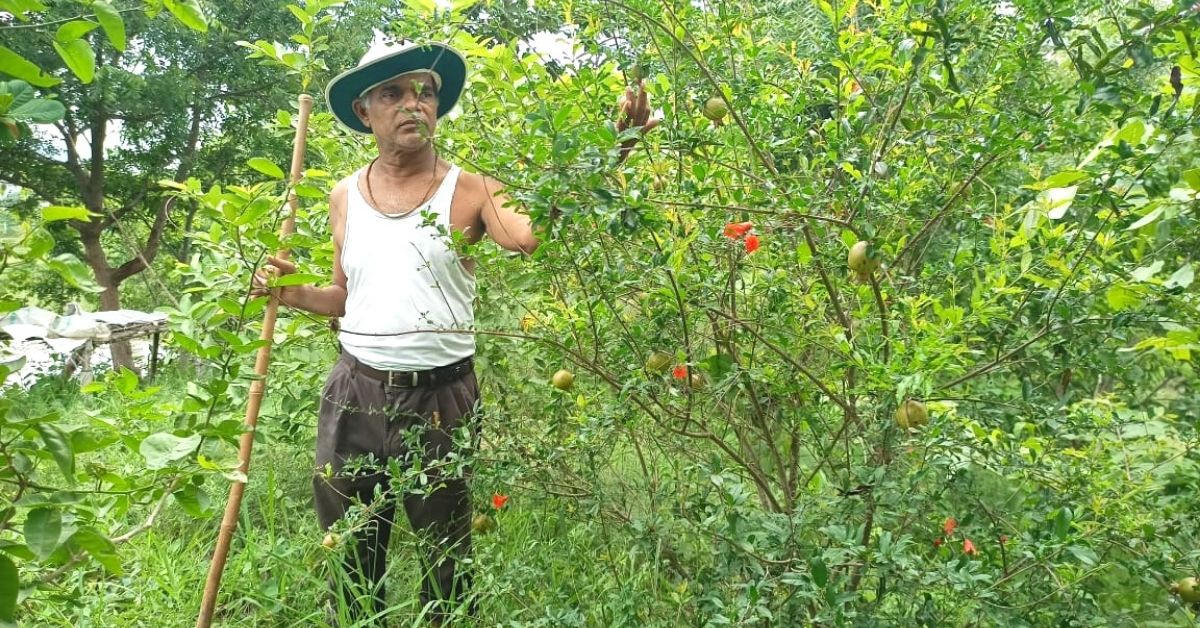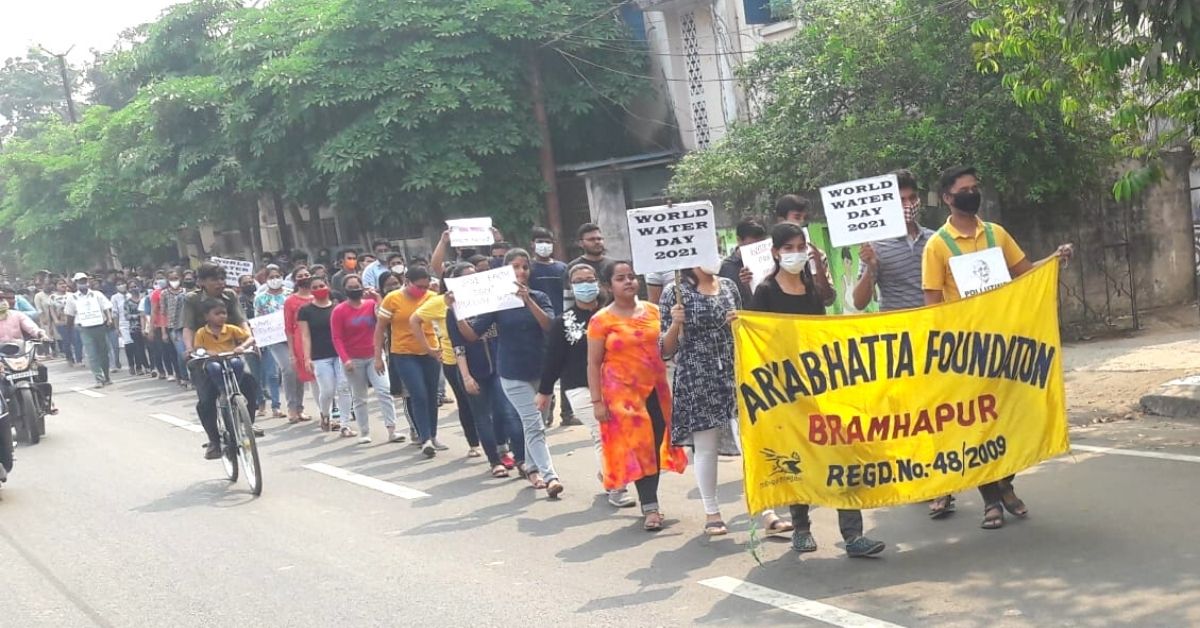16 Years of Tireless Efforts By Teacher Turn 13 Barren Hillocks Green
In Odisha's Berhampur district, school teacher Sudhir Rout defied the destruction caused by frequent cyclones for 16 long years to script a stunning success story of environmental conservation

In 2002, Sudhir Rout, a native of Odisha, became a principal at the Nalanda Residential college in Vijayawada. Months after taking charge at the institute, he realised that the 150 engineering students were unwilling to attend classes.
“The classrooms had tin roofs, which made it unbearable for the students, considering that Vijayawada is one of the hottest places in India,” he tells The Better India. This, coupled with unhygienic washrooms and poor infrastructure made conditions worse.
So in 2003, Sudhir decided to improve the school’s infrastructure and plant saplings to improve greenery on campus. “I planted saplings of varieties that would cover the classrooms with their wide canopy. Over the next couple of years, the canopy grew, protected the classrooms from extreme heat, and made the surroundings pleasant,” the 59-year-old says.
“I never had much interest in the environment and trees before this. But I was impressed by how the flourishing environment had helped improve attendance of students. So I continued plantation drives here until 2005,” he adds.
A lush paradise across 13 hillocks

The same year, he returned to his hometown Berhampur and started Aryabhatt Coaching Centre offering private tutoring to teach physics. Alongside, he continued his work on the environment. “I started planting trees along roads and empty public spaces,” he explains, adding that he started with 50 trees along a lake, but was unsuccessful.
In 2008, he planted another set of 300 saplings along the roads, and was successful this time. “No one helped me during that time. But I felt that planting trees could bring people closer to the forest and nature,” he says.
In 2010, Sudhir stepped up by using a vehicle to create awareness among people. “The vehicle was called Sabuj Rath, or green chariot, which came armed with a mic and loudspeaker. I started announcing messages on the importance of protecting the environment and nature in the hope of motivating people to join the cause,” he adds.
However, around 2013-14, he faced a setback as most of his roadside plantations came under the axe due to road widening work. This was followed by cyclone Phailin. “The loss was heavy, but I managed to save 90 per cent of the damaged or uprooted trees,” he says. Learning from the setbacks, he decided to identify a safer place for the plantations.
In 2016, he located a 32 hectare common land in Ganjam block, where villagers would bring their cattle for grazing. He planted 1,100 saplings in a place where the soil was degraded and not helpful for the plants. “I brought fertile soil from outside to layer and add nutritional value. About a 1,000 plants survived due to the effort,” he explains.
Sudhir focused on native trees that require less maintenance, such as the banyan, date and other varieties. He also took help from the forest department, school and university students.
“In 2017, about 100 volunteers came together to throw 1.5 lakh seed balls of native varieties in village hillocks. About 30% germinated with 40,000 plants,” he says.

Sudhir adds that the same year, he identified another 5-acre land to plant 5,000 trees. “We made it a reserve jungle and planted shade-giving and fruit-bearing trees like jamun, coconut, pomegranate and others,” he says.
He further involved volunteers in awareness programmes by forming groups of 20-25 and handing them the responsibility of speaking about environmental protection in their respective districts.
Besides promoting the planting of trees, the volunteers also spread awareness about protecting the existing green cover and reducing water pollution. “They advised residents to avoid dumping waste in water bodies. Thousands of fish die if any toxic chemical enters water bodies,” he says. “It is important to adopt a holistic approach, and protecting water bodies is part of that.”
In 2018, Sudhir convinced more villagers in neighbouring areas to allot nine hillocks, a part of the commons — land used collectively by villagers to graze cattle — to be converted to green covers. In addition to another three, the number of hillocks has totalled to 13 today.
To date, over 80,000 saplings have been planted and 5 lakh seedballs dispersed in an attempt to create green cover across the hillocks.
“The trees have started bearing fruits from the previous plantations. However, it would take a few more years for ample fruiting and for the villagers to reap benefits by selling them or consuming themselves,” he says.
A green cause to benefit all
Sushant Mohanty, a villager from Madhabandha, says the Ganjam block has faced the brunt of all major cyclones such as the Titli, Phailin and Amphan. “The cyclones devastated all vegetation and trees in the vicinity. It was only when Sudhir sir took the initiative of planting 15,000 trees that the residents of the villages experienced cooler weather during harsh summers,’ he says.

Sushant says that the villagers have observed the soil quality improve and increase its water retention capacity, thus reducing erosion during extreme weather conditions.
“The increase in vegetation has attracted wildlife including rabbits, peacocks, blackbucks, butterflies and others. Rabbits have become a common sight, and villagers who visit the area daily report their presence through the area,” he says.
However, Mandar Datar, a biodiversity scientist at Pune-based Agharkar Research Institute, warns of changing the natural landscape excessively. He says, “Increasing the green cover is a good initiative. However, utmost care needs to be observed, ensuring that the local flora and fauna remain unaffected. Barren land with grasslands is also an ecosystem and should be untouched.”
He adds that even with the fruit-bearing native tree plantation, steps should be taken so that the local biodiversity is not affected in excess, thereby altering the geographic vegetation drastically.
About facing challenges in his endeavour, Sudhir says that he has spent around Rs 32 lakh since 2002 to plant trees and for other green efforts. “I have used all the funds from my earnings. It is also difficult to explain the importance of the environment to the villagers. They may not understand all aspects of nature at all times,” he says.
Sudhir says he believes in working without any government or private group support, so that there is less influence of their policies. Alongside, he also wants to stay away from the limelight. “I feel that society should grow, and it is possible only if the environment around them flourishes and supports them. Individual growth is always limited to benefitting one person. However, environment conservation helps with oxygen, fruits and offers many aspects of livelihood to the masses. That is why I focus on working towards the green cause,” he adds.
Edited by Divya Sethu
If you found our stories insightful, informative, or even just enjoyable, we invite you to consider making a voluntary payment to support the work we do at The Better India. Your contribution helps us continue producing quality content that educates, inspires, and drives positive change.
Choose one of the payment options below for your contribution-
By paying for the stories you value, you directly contribute to sustaining our efforts focused on making a difference in the world. Together, let’s ensure that impactful stories continue to be told and shared, enriching lives and communities alike.
Thank you for your support. Here are some frequently asked questions you might find helpful to know why you are contributing?


This story made me
-
97
-
121
-
89
-
167













